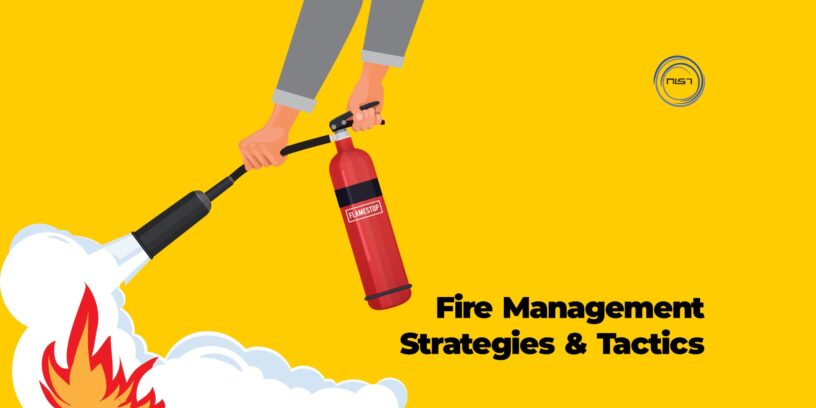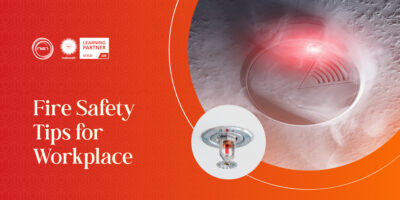Fire is one of the most dangerous disasters. The use of fire as a weapon dates back to antiquity and was used by the Greeks and other ancient civilizations. It’s also a frequent cause of major fires that destroy property and cause harm to people’s health. This led to the introduction of numerous fire management strategies and tactics on how to deal with every kind of fire, no matter how small or large, accidental or purposeful, occurring at home or at work, natural or man-made, etc.
The necessity of fire management plans and techniques:
Countries have re-engineered their fire management strategies to save lives during major fires and use safety courses to train people on how to deal with major fires before they occur. This is mandatory in saving lives and properties as firefighting requires well-trained personnel.
The Importance of Fire Safety Training for a Safe Workplace:
Fire is a very real threat to the existence of any organization; it can lead to loss of data, property, and people, and even cause death and injury to many people, including those who work in the office or factory where the fire occurs. An organisation benefits from providing staff with fire safety training in numerous ways.
Furthermore, the reason why it is important for companies to be prepared for fire is that when a fire occurs, it usually spreads rapidly through a building or office, if not controlled immediately, within minutes or hours, especially in high-rise buildings, causing damage, destruction, and/or injury to people and property due to smoke inhalation, burns, and other injuries resulting from the fire that destroys everything in its path and causes many casualties among both people and property, especially in high rise buildings that are prone to such disasters. Fire prevention can be one of the most effective ways to reduce risk at your facility or organization and save money in the process by minimizing damage and property loss during an emergency situation like fire, smoke, etc. A fire safety plan is vital in order to minimize damage caused by a fire event.
In fact, an employer has a moral obligation to train their staff about how to deal with a fire situation; ensure that they are able to act quickly and effectively to protect themselves and other people in their vicinity from being injured or killed by a fire, explosion or gas leak in the workplace; and to prevent injuries and deaths to themselves and others due to poor work practices or unsafe working conditions in the workplace.
Emergency Response:
Firefighting is a very important part of emergency response. Firefighting is not just about putting out fires; it’s also about preventing new fires from starting. In this era of digitalization, firefighters use advanced equipment that allows them to deal with accidental fires quickly. They use strategies and tactics to put out fires quickly and safely. To be successful in the field of firefighting, you must learn many different skills, including:
- Extinguishing fires in all environments and types
- Knowing how to prevent fires from spreading
- Knowing how to put out fires when they start
- Knowing what to do when dealing with chemicals
- Knowing what to do when dealing with hazardous materials
- Knowing how to manage emergencies
- Knowing what equipment is needed in order to fight a fire.
Occupational Health and Safety Act – 1970:
The purpose of the Occupational Safety and Health Act of 1970 is to “ensure healthy and safe working conditions for working men and women by authorizing enforcement of the standards developed under the Act; by assisting and encouraging the States in their efforts to ensure safe and wholesome working conditions; by providing for research, information, education, and training in the field of occupational safety and health.” The main goals of the Act are to ensure every working man and woman in the nation has safe and healthy working conditions and to protect our human resources.
Strategies and tactics:
The best strategy for putting out a fire is to determine its source in order to prevent it from happening again and minimize the damage it causes before it does. Upon locating the fire, creating a plan would help. As part of the planning process, a fire plan should be drafted to help identify critical areas, define responsibilities, and create a response system for all situations. It must also include provisions for evacuation procedures, fire and rescue communications, and mutual aid agreements.
In addition, the most frequent tactics used are suppression, prevention, rescue, and recovery actions, which call for a specific set of abilities, expertise, and experience in order to be effective and efficient in defending people and property during a fire incident.
People who fight fires must have knowledge of fire safety and law enforcement, as well as physical strength, reflexes, and endurance. They also need specialized equipment such as fire hoses, ladders, rescue tools, breathing apparatuses, and so on. Firefighters also use special vehicles such as firetrucks or aircraft to combat major fires. The strategic plan for fighting fires is to contain the flames until firefighters put out the fire safely with equipment or chemicals.
Types of fire:
Based mostly on the substance burning, fire is divided into five categories (A, B, C, D, and E).
Class A flames involve combustible solids, including coal, cardboard, cloth, and wood.
In class B fires, flammable liquids or liquefied solids like wax, alcohol, and gasoline are involved.
Combustible gases, including butane, propane, and natural gas, are involved in class C fires.
Aluminum, magnesium, and titanium are among the flammable metals involved in class D fires.
Cooking fats and oils are involved in Class F fires.
Assessing dangers and choosing the best kind of extinguishing agent are made easier with the help of the classification system mentioned above.
Assessing and controlling fire risks:
Fire risks can be assessed in terms of their nature and intensity. This can be done with the help of fire risk assessment procedures. These include calculating fire potential—the extent to which a fire can occur based on its nature, location, and building materials used in a building. Fire risk assessment helps outline fire management strategies and tactics to reduce the risk of it happening again.
Also, one could assess the severity of the hazard by evaluating various factors like fire potential, ignition sources, ventilation, fuel load, and distance between flammable materials and heat or flame source, etc.
Risk-reduction measures:
After assessing the severity, one needs to look at the possible risks and take steps to mitigate them. The risk-reducing measures can be categorized as preventive, protective, and detective measures. Preventive measures are those that are applied before the occurrence of an event.
Firefighting is the most important task carried out by firefighters, and their main responsibility is to put out a fire before it damages property or life. They use sophisticated tools such as fire engines, water pumps, and water jet systems to fight a fire effectively. The use of these systems depends on the nature of the fire being controlled. For example, if it’s an electrical fire, carbon dioxide extinguishers are used as CO2 helps to prevent the combustion of flammable liquids and electric fires. Foam extinguishers are used in the case of class A and B fire risks. Dry powder extinguishers are used for A, B, and C fire types. Wet chemical extinguishers are used to put out both class A and class F fires. Foam extinguishers are used for both class A and B fire risks.
Benefits:
Utilizing fire management strategies and tactics aids in preventing fires and,
- Countries with strong fire management strategies have fewer fatalities from fires
- By using a fire management strategy instead of tactics you will reduce the time that you need to fight a fire: The sooner you learn to deal with fires, the sooner the fire stops burning and the more of the premises can be saved. As soon as you realize fire is there and you have time to act, the chances of damage being caused by the fire are greatly reduced. When you have more time to deal with the fire, you can get more of the fire under control.
- Protects neighboring properties
- Reduce property damage
- Reduce your business risk
- Increases firm’s productivity and profit
- Helps in compliance of Fire safety rules and regulations
- Reduce cost of insurance
- Also helps people who work in the IT industry, as they can prevent fires from spreading through computers, monitors and other electronic devices
Who could take a fire safety course?
Any representative/Volunteers of an organisation
HSE professionals
Warehouse Safety Manager
Fire Officer
Sub Fire officer
Safety supervisor
Health and Safety department members
Employees
Why NIST?
Our fire safety training provides your workers with the knowledge, skills, and abilities to recognise the danger signs and symptoms of fires in their environment and to take appropriate actions to protect themselves and fellow workers. Organizations need to train their employees on fire safety at all levels of the organization—managers, supervisors, workers, and other team members; all should understand the importance of fire safety precautions in the workplace and be aware of how to perform fire drills and how to deal with a fire emergency if one occurs in the office or plant, as well as what to do when a fire does occur in their area of work or home environment, including what to do before evacuating an area, what to do during evacuation, and how to handle the aftermath of a fire. Happy Learning!













Leave a Reply